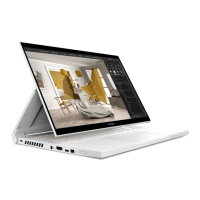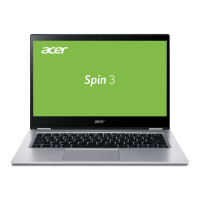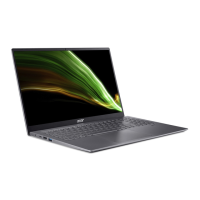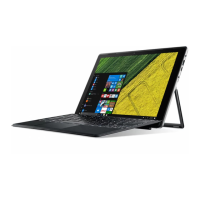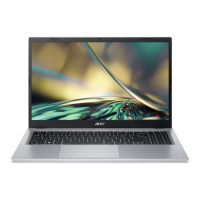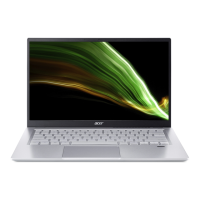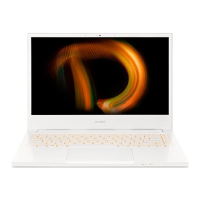
Do you have a question about the Acer ConceptD 3 and is the answer not in the manual?
| Form factor | Clamshell |
|---|---|
| Product type | Laptop |
| Product color | White |
| LED backlight | Yes |
| Display diagonal | 15.6 \ |
| Native aspect ratio | 16:9 |
| Processor cache | 12 MB |
| Processor cores | 6 |
| Processor model | i7-10750H |
| Processor family | Intel® Core™ i7 |
| Processor frequency | 2.6 GHz |
| Processor cache type | Smart Cache |
| Configurable TDP-down | 35 W |
| Processor manufacturer | Intel |
| Processor boost frequency | 5 GHz |
| Internal memory | 16 GB |
| Internal memory type | DDR4-SDRAM |
| Maximum internal memory | - GB |
| SSD capacity | The Solid State Drive's storage capacity in Gigabytes. |
| SSD interface | PCI Express |
| Storage media | SSD |
| Total storage capacity | 1000 GB |
| Number of SSDs installed | 1 |
| Discrete GPU manufacturer | NVIDIA |
| Discrete graphics card model | NVIDIA® GeForce® GTX 1650 Max-Q |
| On-board graphics card model | Intel® UHD Graphics |
| Discrete graphics card memory | 4 GB |
| Discrete graphics memory type | GDDR6 |
| Number of microphones | 2 |
| Front camera HD type | HD |
| Front camera resolution | 1280 x 720 pixels |
| Antenna type | 2x2 |
| Wi-Fi standards | 802.11a, 802.11b, 802.11g, Wi-Fi 4 (802.11n), Wi-Fi 5 (802.11ac), Wi-Fi 6 (802.11ax) |
| Top Wi-Fi standard | Wi-Fi 6 (802.11ax) |
| WLAN controller model | Intel Wi-Fi 6 AX201 |
| Ethernet LAN data rates | 10, 100, 1000 Mbit/s |
| Charging port type | DC-in jack |
| USB 2.0 ports quantity | USB 2.0 ports have a data transmission speed of 480 Mbps, and are backwards compatible with USB 1.1 ports. You can connect all kinds of peripheral devices to them. |
| USB 3.2 Gen 1 (3.1 Gen 1) Type-C ports quantity | 0 |
| Keyboard layout | QWERTY |
| Pointing device | Touchpad |
| Keyboard language | US English |
| Operating system architecture | 64-bit |
| Battery capacity | 56 Wh |
| Battery life (max) | 14 h |
| AC adapter power | 135 W |
| Cable lock slot type | Kensington |
| Depth | 259 mm |
|---|---|
| Width | 358.14 mm |
| Height | 17.78 mm |
| Weight | 2199 g |
Overview of guides provided for new users.
Advice on maintaining the computer and its components.
Details laptop screen components and keyboard layout for user navigation.
Identifies and explains the various ports and connectors on the notebook.
Explains Caps Lock, Num Lock, and other special function keys.
Details keyboard shortcuts using the Fn key for quick actions.
Provides guidance on navigating and using Windows features.
Explains finger gestures and guides on customizing touchpad behavior.
Procedures for backing up data and system drivers, and restoring the PC.
Guides on resetting the PC, with options to keep or remove personal files.
Steps to manage Bluetooth and connect new devices.
Instructions for connecting to Wi-Fi and Ethernet networks.
Introduction to the software for system control and monitoring.
Customizing screen profiles, audio modes, and system performance.
Personalizing keyboard functions, launching apps, and using color tools.
How to enable and configure the Bluelight Shield feature.
Using physical locks and setting up BIOS/boot passwords.
Procedures for password entry and system protection.
Steps to configure the fingerprint reader for Windows Hello sign-in.
Configuring boot order and setting BIOS passwords.
Tips and settings to conserve battery power and optimize usage.
Details about the battery, how to charge it, and initial conditioning.
Tips for optimizing battery life, checking status, and handling low battery warnings.
Steps for disconnecting, securing, and transporting the computer.
Explains the purpose, types, and safe removal of USB devices.
Details about Thunderbolt 4 ports and display support.
Guides for connecting external displays and audio peripherals.
Explanation of the HDMI interface for audio/video connections.
Guidance on resolving common system issues and interpreting error messages.
Initial steps for securing your computer and activating protection.
Setting up networks, browsing the internet, and using Acer resources.
Understanding threats, preventing infections, and securing public Wi-Fi.


